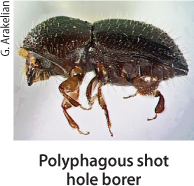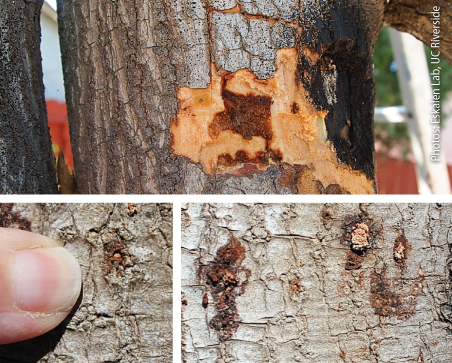All Issues
New insect-disease complex strikes Southland trees
Publication Information
California Agriculture 66(4):121-121.
Published online October 01, 2012
PDF | Citation | Permissions
NALT Keywords
Full text
RIVERSIDE, Calif. — UC Riverside scientists have identified a new insect-disease complex that is threatening avocado, coast live oak, box elder and other trees in Southern California. The complex includes a new shot hole borer and a symbiotic Fusarium species, which causes branch dieback. The same beetle and fungus have also been found in Israel, where the complex has caused severe damage to avocado trees since 2009.
Entomologists led by Richard Stouthamer proposed the name polyphagous shot hole borer (PSHB) for the tiny insect, an ambrosia beetle. Smaller than a sesame seed (the female is 0.1 inch), the insect was earlier misidentified as tea shot hole borer. Subsequent DNA sequencing by UCR scientists distinguished the insect as a different, potentially new, species.
After it bores into a tree, the insect deposits the fungus, which causes branch dieback and eventual death of the tree. The yet unnamed Fusarium sp. was identified by Akif Eskalen, UC Riverside Cooperative Extension plant pathologist.
Eskalen has linked the insect-disease complex to the branch dieback and general decline of several avocado and landscape trees found in February and March this year in Los Angeles and Orange County residential neighborhoods.
The insect and fungus have a symbiotic relationship, Eskalen says. “When the female beetle burrows into the tree, it lays its eggs in galleries; the eggs develop into larvae, which feed on the fungus,” he explains. “At the same time, the fungus attacks the vascular tissue of the tree, disturbing water and nutrient flow, and causing branch dieback and — if not stopped — the tree's death.”
If infected branches are cut off early enough, trees can be saved. It is important that growers and homeowners not move infested avocado wood out of the infested area.
Symptoms in avocado include the appearance of white, powdery exudate in association with a single beetle exit hole on the bark of the trunk and main branches of the tree. This exudate could be dry, or it could appear as a wet discoloration.
If you suspect you have found the PSHB or seen symptoms of Fusarium dieback in your avocado grove or in other host plants, please contact your local farm advisor, county agricultural commissioner, or UC Riverside's Eskalen at akif.eskalen@ucr.edu or (951) 827-3499. — Iqbal Pittalwalla and Janet White






